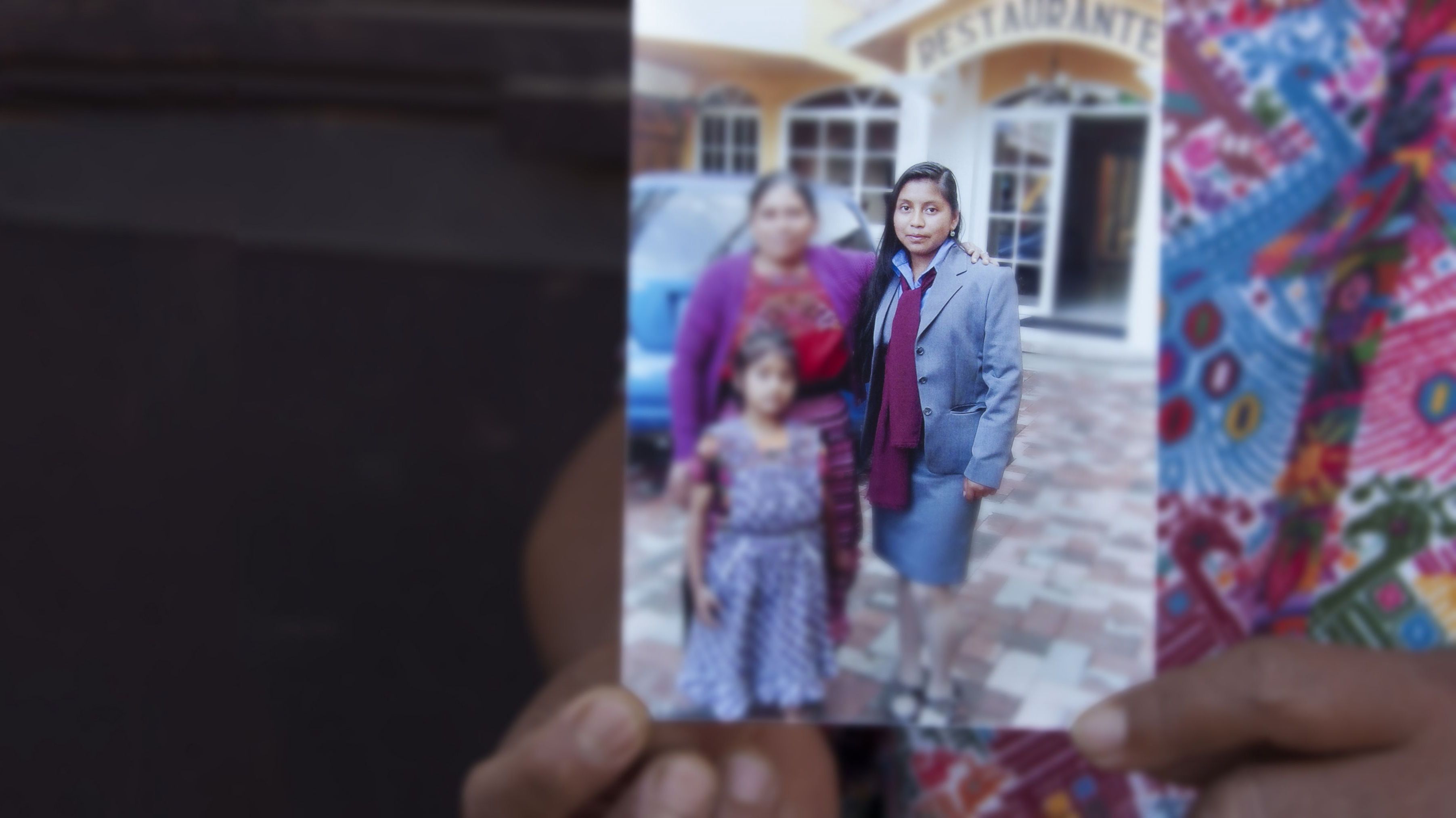Credible Fear
Trump’s calls for a border wall won’t make it harder for domestic violence survivors to find refuge in the U.S.—a new ruling is already doing that. Marie Claire goes to Tijuana to see what women fleeing abuse endure in seeking asylum.
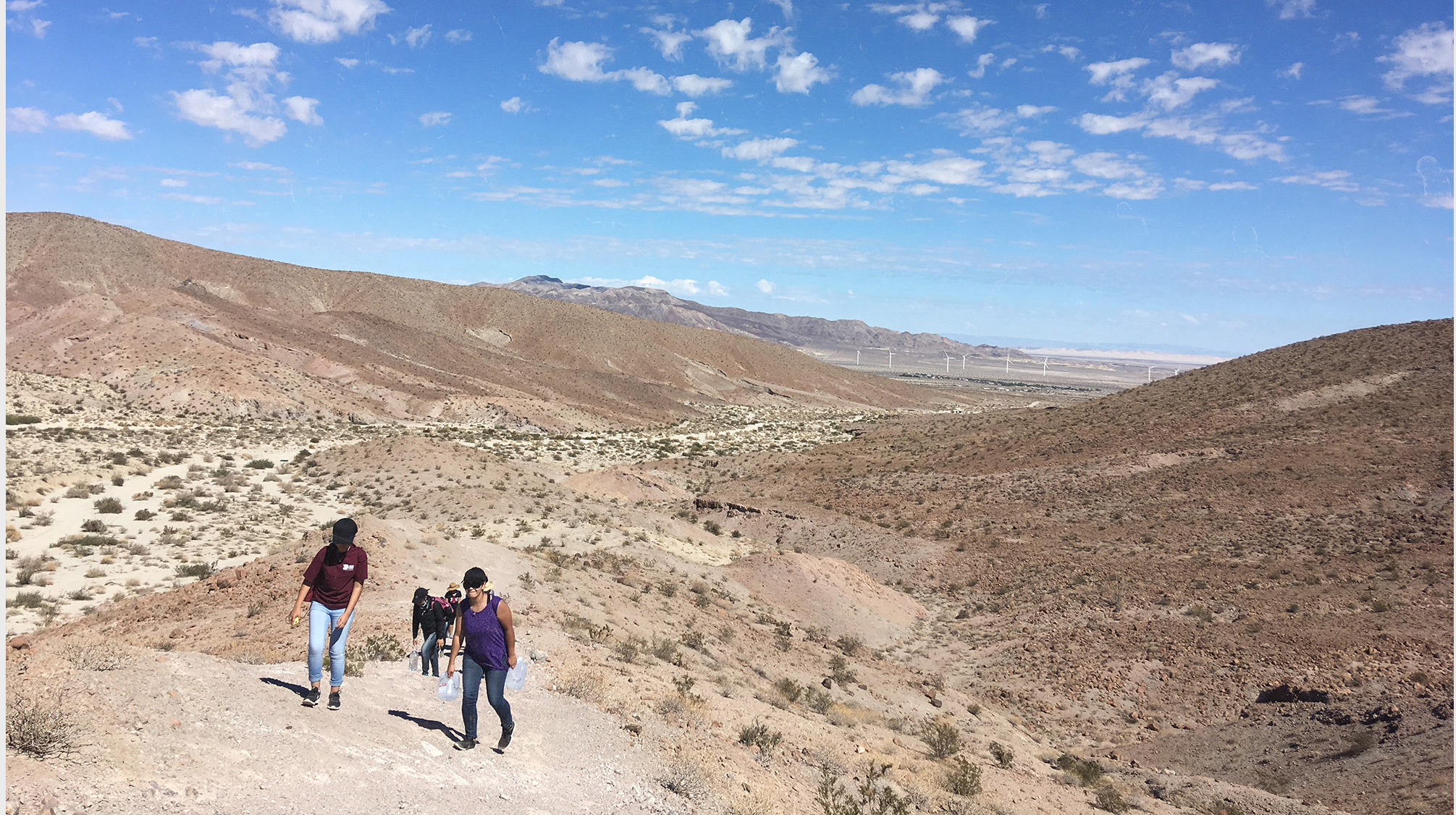
It’s still dark and damp when Gabriela steps onto Tijuana’s El Chaparral Plaza on a chilly October morning. In a few hours, the sun will creep through the clouds, but for now, the sky is a vast slate of grey and her lips are cold. Her fellow asylum seekers, hovering nearby with hands shoved in their pockets, wait every morning at the plaza—just a few hundred feet from the United States border. Most wear weathered jeans, hoodies, and worn sneakers. They huddle in groups and chat to pass the time, ruffling the hair of restless kids tugging on their sleeves. What binds everyone there—a mélange of nationalities and stories—is uncertainty. Everyone is playing the waiting game, unsure of when they will be allowed to apply for asylum in the U.S. or what will happen if they get to the other side of the border.
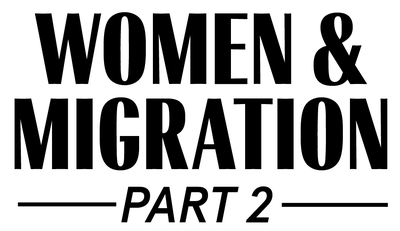
For Gabriela (whose name has been changed to protect her safety), this strange in-between zone has been a fact of life since September 2018, when she and her three children arrived in Tijuana from the state of Michoacán, Mexico, which has become the epicenter of the drug war. Gazing out at the sea of grim faces in front of her, Gabriela says she is looking forward to the day they can leave this place behind, when she will present herself to U.S. immigration officials and make her case. So are her kids—two daughters, ages 15 and 10, and an 8-year-old son. “They are calm and excited about our turn,” she says.
Gabriela has a deliberate way of speaking that makes her seem older than her 33 years. She describes herself as the kind of person who finds “the silver lining” in any situation. But beneath the surface of Gabriela’s optimism lies an ever-present worry. If she doesn’t win her asylum case, she and her children may have to go back to Michoacán, where her abusive ex-boyfriend, a doctor, lives. Moving elsewhere in Mexico didn’t seem far enough—Gabriela feared her ex, who used to work in her town’s local government, could leverage his contacts in politics and law enforcement to track them down. He “was protected by the government, by the police. They offered to make people disappear for him,” Gabriela says, explaining why she never filed a police report. The best way to keep her family safe, she decided, was to ask for asylum in the U.S.
But when Gabriela set foot in Tijuana’s square, she didn’t realize that she had stepped out of one battlefield and onto another, one waged in the realm of bureaucracy and policy. Suitcases in hand, children by her side, she strode into the plaza ready to move forward, unaware that she was standing at the edge of a labyrinth, whose twists and turns threatened to leave her right where she started.
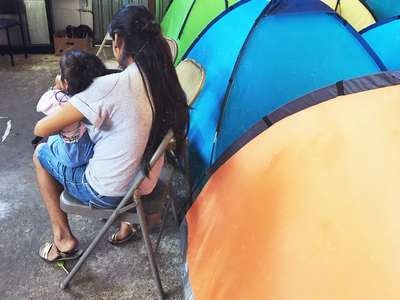
A domestic violence survivor sits with her child at the Juventud 2000 shelter for migrants in Tijuana.
Over the past year, the Trump Administration has introduced a series of policies intended to make the process of applying for asylum increasingly difficult. A 2016 rule already limited the number of people allowed to apply for asylum at official ports of entry each day, forcing thousands of asylum-seekers to return to Mexico while they await their immigration court hearings in the U.S. Last summer, in a move that takes aim at people like Gabriela, the Justice Department narrowed the eligibility for people fleeing domestic and gang violence. Most recently, President Trump proposed charging asylum seekers a fee to apply and suggested the U.S. do away with the asylum system altogether, because, as he told reporters: “It doesn’t work.” Together, immigration advocates say Trump’s comments and policies amount to a war on asylum seekers, meant to send a clear message that America as a safe haven is a thing of the past.
The shift away from granting asylum to domestic violence survivors is a sharp reversal from a groundbreaking 2014 ruling by the Board of Immigration Appeals, the nation’s highest immigration court, granting asylum to a survivor for the first time. The survivor, Aminta Cifuentes, who was viciously abused by her husband in Guatemala for a decade, was able to make the case that her country’s government was unable to protect her by proving she had repeatedly gone to the police, which would not intervene in what they called a domestic dispute. The decision to grant Cifuentes asylum formally recognized domestic violence as a legitimate form of persecution and paved the way for other victims to find refuge in the U.S. But last June, then-Attorney General Jeff Sessions reversed the immigration appeals court ruling, arguing that people fleeing abusive partners and gangs were largely victims of what he called “private” violence, rather than government persecution. He decided that such claims, in general, would no longer qualify for asylum.
He was protected by the government, by the police. They offered to make people disappear for him.
Asylum cases can take years to resolve, so it’s too soon to see the full impact of Sessions’ decision. But by mid-October, the initial effects of the administration’s new policies were already clear. Limiting the number of asylum seekers, for example, has extended the wait times at already clogged ports of entry like San Ysidro—the busiest land border crossing in the Western hemisphere, which processes about 20,000 pedestrians and 70,000 cars passing between Tijuana and San Diego each day. In the face of weeks or months-long wait times, some asylum seekers, including hundreds of people who were part of the migrant caravan from Central America that arrived in Tijuana in November, have chosen to return to their home countries or apply for asylum in Mexico instead. Many others will keep trying. “It's faith that drives them,” says Esmeralda Siu Márquez, a coordinator with the Coalition for the Defense of Migrants, a network of migrant’s rights groups in Mexico. “When they experience something so violent, they cling to a dream.”
Get exclusive access to fashion and beauty trends, hot-off-the-press celebrity news, and more.
For Gabriela, the abuse began on a sacred day. It was her 6-month-old daughter’s baptism, 10 years ago, when she got into an argument with her then-boyfriend about one of their other children. Things got heated, and Gabriella recalls, “He hit me very hard.” Before that, he had been jealous and short-tempered, but never violent. He apologized and vowed never to hit her again. But he did. Over the next decade, he beat Gabriela repeatedly; one time, he raped her—a fact she has never before revealed. “Apart from the physical aggression, there was also verbal aggression that sometimes hurts you as much as the punches,” she describes with tears in her eyes. Her oldest daughter witnessed some of the abuse. He hit her too, Gabriela says, and once threatened to murder them both. Her daughter grew sullen and withdrawn. A few years ago, she started cutting herself; today, thin lines of scars run up and down her forearms.
In many parts of Latin America, violence against women is pervasive and permissible. According to the United Nations, it is the most violent region for women on earth, with “epidemic levels” of femicide in Mexico and in Central America’s Northern Triangle (Honduras, El Salvador, and Guatemala). In Mexico alone, according to statistics from the country’s Interior Ministry, 861 women were murdered in 2018—and more than 52,000 women are believed to have been killed between 1985 and 2016, a report from UN Women found. But the killers are rarely brought to justice. Between 2012 and 2013, less than 2 percent of 613 femicide cases in Mexico resulted in a conviction, according to the National Citizen Observatory on Femicide. “Why do men kill women?” asks Soraya Vázquez Pesqueira, a Tijuana-based lawyer and human rights activist. “Because they can. Because they do it and nothing happens.”
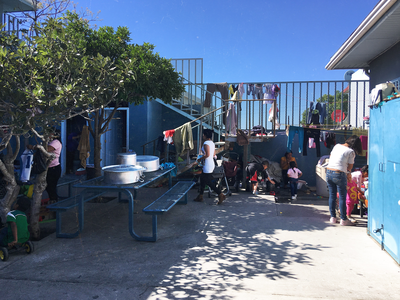
A scene from the outdoor courtyard of the Madre Asunta shelter for women and children migrants in Tijuana.
Not wanting to become a statistic, Gabriela decided to flee. Getting to Tijuana was a multi-pronged journey. First, she and the kids took a bus to a relative’s house in a different state several hours away. They stayed with him for about three months, but Gabriela grew concerned that her ex would try to find them. When she had tried to escape years before, her ex tracked her down and brought her and the kids home. This time, a friend encouraged her to go further away and urged her to apply for asylum in the U.S., buying plane tickets to Tijuana for Gabriela and her children. The trip would have been impossible otherwise; Gabriela left home with no savings.
When they landed in Tijuana, they went straight to the San Ysidro Port of Entry to request asylum before learning they would have to wait about a month to apply due to the long line of people ahead of her. Gabriela found space at a nearby shelter and passed time by volunteering in the shelter’s kitchen and waitressing at a restaurant a few blocks away. Her kids went to class every few days at a school down the street.
Why do men kill women? Because they can. Because they do it and nothing happens.
Gabriela hoped she would win, but the odds are not in her favor. According to Syracuse University’s Transactional Records Access Clearinghouse (TRAC), which tracks immigration statistics, U.S. immigration judges denied 65 percent of asylum cases in 2018, the highest percentage of denials in nearly 20 years. For Mexican and Central American asylum seekers, the outcomes were even more dismal: In 2018, according to TRAC, 85 percent of asylum claims from Mexico were denied, while applicants from Honduras, El Salvador, and Guatemala were rejected around 80 percent of the time.
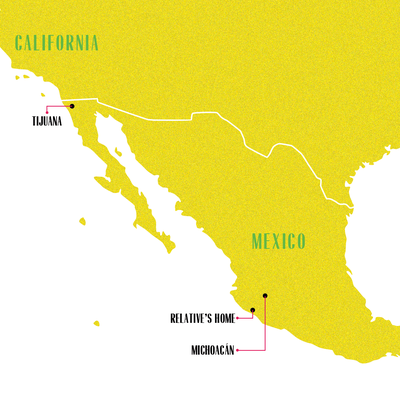
Gabriela's route from Michoácan to Tijuana.
Despite such outcomes, when Gabriela looked at the pedestrian bridge dividing Mexico and the U.S., she could imagine her family on the other side. A handful of her relatives had crossed in recent years and are now living in the U.S. (some legally, others not); she planned to stay with a family member in Delaware. Gabriela knew her family faced an uphill battle, but she believed her story was worthy of protection and that the U.S. government would agree. “If it is a good reason, they’ll allow us in,” she says. “We’ll try and hope to God that we can improve our situation.”
As dawn breaks on a foggy morning in Tijuana, a young woman in a light blue sweatshirt hunches over a black hardcover notebook, jots down a name, and gives a number to a young man in front of her carrying a stack of papers. It’s just past 7:30 a.m., and about two dozen people are lined up along El Chaparral Plaza. Dozens more linger nearby, clutching backpacks and suitcases. Almost everyone is waiting for updates from the infamous notebook, which dictates when they will be allowed to apply for asylum. The system is run by the Mexican government agency Grupos Beta with the help of asylum seekers themselves, who volunteer to oversee the notebook and call out the numbers of those allowed to cross. When a number is called, that person then has a chance to clear the first hurdle to gaining asylum: an initial screening with a U.S. asylum officer during which they must demonstrate they face a “credible fear” of persecution if they return home.
At about 8:30 a.m., the volunteer walks a few paces along the edge of the plaza to announce who would be allowed to cross. A circle quickly forms around her as she calls out numbers. A man carrying a manila envelope approaches her with a scowl. “I have been waiting here for weeks!” he huffs, waving his papers in her face. “We will call more people tomorrow,” she assures him.
One of the people whose name wasn’t called today is Mariana, a young woman from Michoacán who asked to use a pseudonym to protect her safety. Leaning against a fence a few feet away from the line, she explains that she left her ex-boyfriend, who was involved in drug dealing and organized crime, after three years. He hit her throughout their relationship, she says, and kept a vigilant eye on her and her four kids. Mariana wanted to escape but felt stuck. “I couldn't leave my house because he was always watching me,” she says. “He would say he would kill me if I left.”
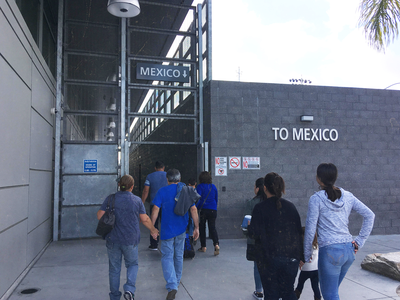
Port of entry crossing to Tijuana from San Diego.
Eventually, she hatched an escape plan. One day, while her boyfriend working, a friend drove Mariana and her kids to the bus station, giving them enough money to buy tickets to Tijuana. They arrived three days later. She left her cell phone in Michoacán so her boyfriend couldn’t track her down. Now that they’re here, Mariana feels a little bit better, but not safe. She worries her story won’t be persuasive enough and she will fail her interview and be sent home.
Even before Sessions changed the eligibility requirements for domestic violence asylum seekers, the question of whether or not abused women like Mariana should be granted refuge was controversial. The modern asylum system emerged from the ashes of the Second World War as nations around the globe reckoned with their failures to provide safe harbor to refugees fleeing Nazi oppression. After the war, when the members of the newly formed United Nations met for the 1951 Refugee Convention and its 1967 Protocols, they established a principle known as non-refoulement, which prohibits asylum seekers from being returned to countries where they are likely to be tortured or killed. They also officially defined a refugee as someone fleeing persecution on account of his or her race, religion, nationality, political opinion, or membership in a particular social group. That definition is still used today to evaluate asylum claims in the U.S. Although there have been cases that recognize some forms of gender violence (like female genital mutilation) as a form of persecution, gender is not explicitly included in that list and over the years there’s been much debate about how domestic violence claims fit into the asylum framework, if at all.
Sofia and her daughter fled to Mexico; her ex found out and called her to say she “wouldn’t make it to the other side.
Shortly after Sessions announced his decision, the U.S. Citizenship and Immigration Services (USCIS) released a memo instructing its officers to generally deny domestic violence and gang-related claims during the credible fear screening phase. After the guidance was released, immigration attorneys reported a rise in rejections of credible fear claims. In August, the ACLU and the Center for Gender and Refugee Studies filed a lawsuit in federal court challenging the new guidelines and a judge ruled in their favor in December. Now, at least in theory, domestic violence victims shouldn’t automatically be turned away. The decision doesn’t apply to the second phase, however, when applicants are granted a court hearing. There, asylum seekers could find themselves before judges who may use Sessions’ mandate to deny their claims—a dynamic some immigration attorneys have already reported. Karen Musalo, the director of the Center for Gender and Refugee Studies, says that before the December ruling, “there was anecdotal evidence that the Attorney General’s decision was having a negative impact and that cases were denied on that basis.”
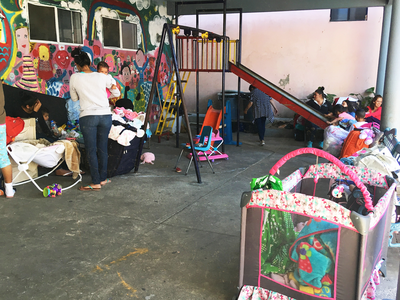
A scene from the courtyard of the Madre Asunta shelter for women and children migrants in Tijuana
The diminished chances of gaining asylum wears on the women living at Instituto Madre Asunta, a shelter in Tijuana for women and children about a 10 minute drive from the border. Behind a tall iron gate in a jam-packed courtyard, Sofia, a 22-year-old from El Salvador, sits on a bench outside with a handful of new friends, her 1-year-old daughter perched on her lap. Sofia had run away from an abusive partner who beat her while she was pregnant, choking her so violently he left marks on her neck. A few months earlier, he had been released after serving a year-and-a-half prison sentence (for “living a bad life”). While he was behind bars, Sofia ended the relationship. “I didn’t want to be with him anymore,” she says. “When he went to prison, that was my opportunity” to leave the abuse behind. He sent her threatening letters while he was locked up, but she ignored them.
Then he was released and Sofia’s sense of security vanished. Her ex wanted revenge, she says, and “came looking for me to hurt me and my little girl.” Sofia and her daughter fled to Mexico; he found out and called her to say she “wouldn’t make it to the other side,” meaning the United States. Terrified, Sofia got rid of her phone. Still, she is especially worried about what would happen if she were to return home. El Salvador has one of the highest rates in the world for the violent deaths of women, with one woman murdered every eighteen hours in 2017, according to the country’s Institute of Legal Medicine. “Violence against women is the biggest problem in El Salvador,” Sofia says. “If you are a woman and you want to get away from [an abusive partner], they don’t allow you. If you try to leave like I did, they want to kill you.”
Sin Marquez, who works at the shelter, says stories like Sofia’s are common. She estimates about one-fifth of the women at the shelter are fleeing domestic violence. Making it to Tijuana does not guarantee their safety. “We have seen cases in which men come here—they have the resources and means to find [where the women are hiding],” Sin Marquez says. “Sometimes, the women tell a family member and that family member accidentally tells so the men find out that they are here.”
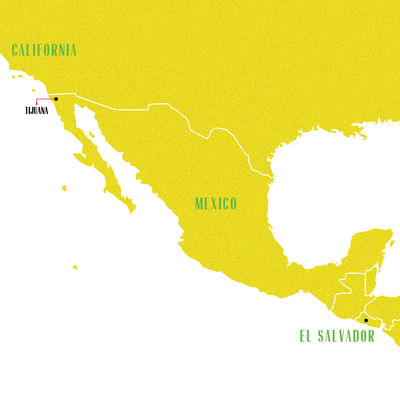
Sofia's journey from El Salvador to Tijuana.
For Sofia, the thought of her ex finding her in Tijuana doesn’t seem too far-fetched. She has heard through family back in El Salvador that he knew she was there. He hadn’t been seen around town back home for at least a week and Sofia feared he was on his way to her. With the threat looming, she was eagerly waiting her turn to ask for asylum. “I'm nervous but I trust God a lot,” she says. “And God willing, I'm going to get asylum. I had too many threats from him and I am very afraid to return. He and his gang are everywhere and if they find me, I know I will not survive.”
The Otay Mesa Detention Center sits off a long, desolate road in San Diego, a vast complex a few miles north of the border. With its high walls and imposing buildings, it would be easy to mistake the center for a penitentiary. To enter, you must first walk through a tall, electric fence topped with razor wire; inside, detainees wear jumpsuits.
The bleak complex houses an immigration court. This morning, Kirsten Zittlau, a San Diego-based immigration attorney, is representing a brother and sister from El Salvador. The pair say they lived in a precarious zone between two rival gangs and were targeted by both. One gang asked to store weapons and drugs inside their house; when the family declined, members threatened to kill them. In court, the sister says she has reason to believe the gang would make good on their threats: Two years earlier, another gang tried to recruit her other brother, then murdered him when he refused to join. They didn’t feel safe relocating within El Salvador, she adds, because she felt certain the gangs would track them down.
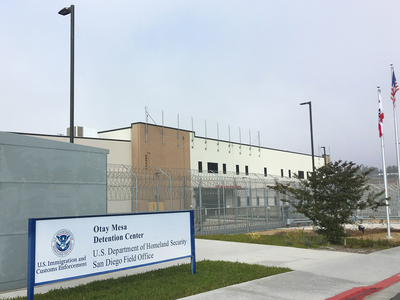
The outside of the Otay Mesa Detention Center in San Diego, California.
The judge doesn’t seem swayed by their testimony. “So you’re saying nobody in El Salvador can move?” she asks incredulously. “Is your whole country controlled by gangs?” “Yes,” the sister replies. When the hearing breaks about two hours in, Zittlau approaches the siblings and outlines the challenges: “You see why we lose,” she says flatly. The brother nods his head in agreement. “The judges feel compelled to follow Sessions’s decision even though it flies in the face of asylum law,” Zittlau adds.
One month after Sessions’s ruling, Zittlau also lost a domestic violence case. Her client was a Guatemalan woman whose husband beat and sexually assaulted her for more than 10 years. He refused to let her use birth control, so she had five children, “which wasn’t her choice,” Zittlau says. In court, Zittlau’s client testified about the abuse for six hours, but the judge found her account “not credible.” “She had poured her heart out for hours,” Zittlau says. “When our system is retraumatizing them is when it gets to me.”
The following weekend, Zittlau joined the nonprofit organization Border Angels to distribute gallons of water for migrants trying to cross into the U.S. through a stretch of desert in the Jacumba Mountains. Scattered in the brush, Zittlau noticed a small, tattered turquoise bra and decaying t-shirt that looked like they had belonged to a teenager. Standing there, Zittlau thought back to the case she had just lost, to the grim estimation that more than half of female migrants are sexually assaulted on the journey to the U.S. “If they can't do it legally then this is what they have to resort to,” she says. “Being raped in the desert.”
When our system is retraumatizing them is when it gets to me.
Despite the odds, there are a lucky few who make it through legally. Gabriela was eager. Her time in Tijuana had dissolved into what felt like one long day. The city was the grey zone; in America, perhaps they could find firmer ground. Zipped inside her bag, she kept a scrap of paper containing the contact information for all of her family members, including the relative in Delaware. She had stored that number in her cellphone, but just to be safe, she also wrote it down.
A month later, Gabriela had good news to report: She and her children had made it through and were now in Delaware awaiting their asylum hearing, which, as of press time, has yet to be scheduled. “My children are fine. We were allowed to pass,” she texts. “I think everything is going well. Now, we are okay, thank God.” For the time being, she felt good. Most importantly, she and her kids were safe. For Gabriela, the grey zone had a silver lining after all.
Reporting for this story was supported by the International Women’s Media Foundation as part of its Adelante Latin America Reporting Initiative.
WOMEN & MIGRATION: PART 1
